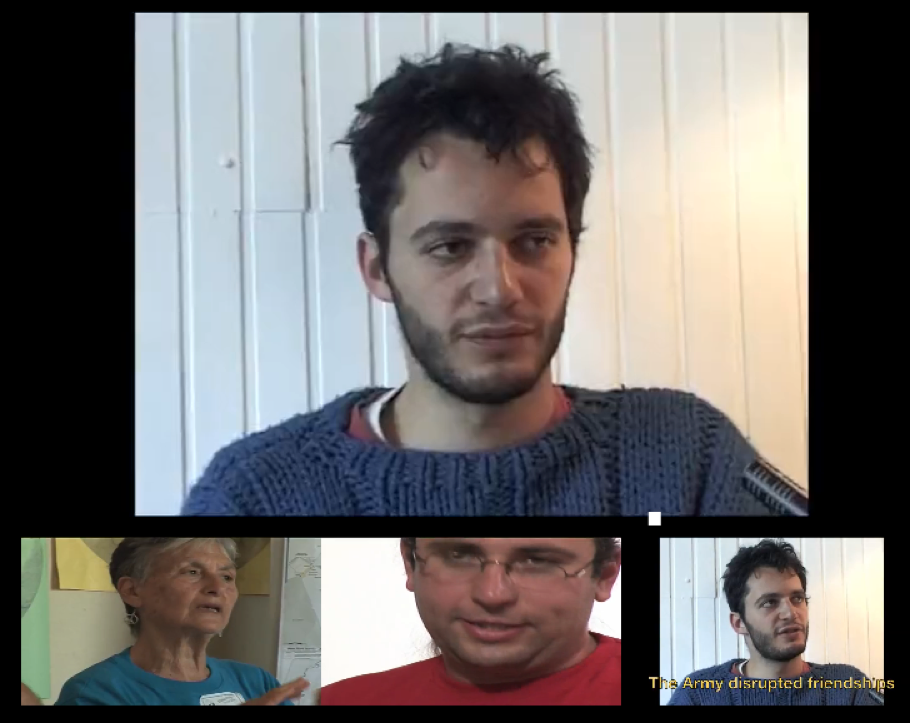The Only Democracy? » Human Rights Activists in the Crosshairs » Video: Israeli Soldiers Violently Evict Hebron House
Video: Israeli Soldiers Violently Evict Hebron House
From the Popular Struggle Coordination Committee
Tuesday, 3 April 2012
“Youth Against Settlements’” Badia Dweik: “While we were violently evicted, the army treats settlers with kid gloves.”
While Israeli PM and his ministers scramble to prevent the eviction of a Palestinian-owned house in Hebron that was taken over by Jewish settlers last week, a video documenting the violent eviction of Palestinian activists from a nearby house owned by the Hebron municipality two days ago, shows extensive use of force.
The eviction, which took place on Sundayy in the Old City of Hebron, was carried out by a large force of Israeli Border Police officers. During the eviction, the force heavily employed the use of tear-gas and a foul smelling liquid called “The Skunk”. Additionally dozens were physically assaulted, with at least five of the activists ending up at the hospital. The activists, members of the local group “Youth Against Settlements”, intended to renovate and take residence in the house in order to prevent it from being taken over by Israeli settlers.
The video documents Israeli Border Police officers storming the house, dealing blows to the completely peaceful activist using batons and their rifles. While a Dutch who was arrested was already unconditionally released yesterday, the detained Palestinian activist who is a coordinator of the Youth Against Settlements movement, Issa Amro, was only released today after depositing a 1,000 Shekels bond as bail.
The activists were evicted despite having acquired a written permission to use the premises from the Hebron Women’s Charitable Society, which rents the house from its owners – The Hebron Municipality. Only days earlier, when settlers took over a nearby Palestinian house, Israeli Authorities refrained from employing force, allowing the settlers to remain in the house. Badia Dwaik, an activist with “Youth Against Settlement”, who was inside the house during the eviction said, “The recent takeover of a nearby house by settlers brought about further restrictions on the already heavily constrained Palestinian movement in the area, including for those families living there. While we were violently evicted from a house we had legal rights to, the army treats settlers who took over a Palestinian house with kid gloves”
Background
Over the years, Israel established a number of settlement points in and around the Old City of Hebron, which had traditionally served as the commercial center for the entire southern West Bank. To perpetuate the settlements in the city, Israeli authorities impose a regime intentionally and openly based on the “separation principle”, as a result of which Israel created legal and physical segregation between the Israeli settlers and the Palestinian majority.
This policy led to the economic collapse of the center of Hebron and drove many Palestinians out of the area. The findings of a survey conducted B’Tselem and ACRI in 2007, show that at least 1,014 Palestinian housing units in the center of Hebron have been vacated by their occupants. This number represents 41.9 percent of the housing units in the relevant area. Sixty-five percent (659) of the empty apartments became vacant during the course of the second intifada. Regarding Palestinian commercial establishments, 1,829 are no longer open for business. This number represents 76.6 percent of all the commercial establishments in the surveyed area. Of the closed businesses, 62.4 percent (1,141) were closed during the second intifada. At least 440 of them closed pursuant to military orders.
The main elements of Israel’s separation policy are the severe and extensive restrictions on Palestinian movement and the authorities’ compliance with settlers violence directed at Palestinians. The city’s residents also suffer as a direct result of the actions of Israel authorities.
Restriction on Palestinian movement and the closing of businesses
During the first three years of the second intifada, Palestinians in the city center of Hebron were put under curfew for more than 377 days total, including a consecutive period of 182 days, with short breaks to obtain provisions.In addition, the army created a contiguous strip of land in the City Center along which the movement of Palestinian vehicles is forbidden. The middle of the strip contains many sections of road that the army forbids even Palestinian pedestrians to use. The strip blocks the main north-south traffic artery in the city, and therefore affects the entire city.The extensive prohibitions have led to the closing of hundreds of shops, in addition to those that were closed under military order.
Settler violence
Settlers in Hebron have routinely abused the city’s Palestinian residents, sometimes using extreme violence. Throughout the second intifada, settlers have committed physical assaults, including beatings, at times with clubs, stone throwing, and hurling of refuse, sand, water, chlorine, and empty bottles. Settlers have destroyed shops and doors, committed thefts, and chopped down fruit trees. Settlers have also been involved in gunfire, attempts to run people over, poisoning of a water well, breaking into homes, spilling of hot liquid on the face of a Palestinian, and the killing of a young Palestinian girl.Soldiers are generally positioned on every street corner in and near the settlement points, but in most cases they do nothing to protect Palestinians from settlers’ attacks.
Institutionalized aggression
The increased presence of Israeli soldiers and police in the Hebron city center regularly brings with it violence and harassment towards Palestinians. Violence, arbitrary house searches, seizure of houses, harassment, detaining passersby, and humiliating treatment have become part of daily reality for Palestinians and have led many of them to move to safer places.
Filed under: Human Rights Activists in the Crosshairs · Tags: Badia Dwaik, Hebron, police, Settlers, west bank, Youth Against Settlements








 “You have a choice! Israeli Anti-Militarists Speak”
“You have a choice! Israeli Anti-Militarists Speak”